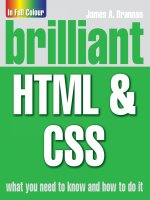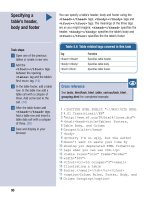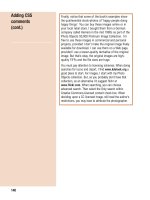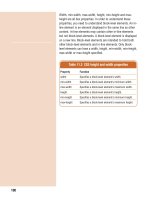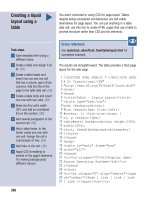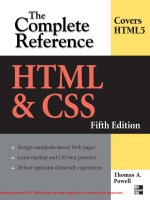Head First HTML
with CSS & XHTML
Wouldn’t it be dreamy
if there was an HTML book
that didn’t assume you knew what
elements, attributes, validation,
selectors, and pseudo-classes were,
all by page three? It’s probably just
a fantasy...
Elisabeth Freeman
Eric Freeman
Beijing • Cambridge • Kưln • Sebastopol • Taipei • Tokyo
Head First HTML with CSS and XHTML
by Elisabeth Freeman and Eric Freeman
Copyright © 2006 O’Reilly Media, Inc. All rights reserved.
Printed in the United States of America.
Published by O’Reilly Media, Inc., 1005 Gravenstein Highway North, Sebastopol, CA 95472.
O’Reilly Media books may be purchased for educational, business, or sales promotional use. Online editions are
also available for most titles (safari.oreilly.com). For more information, contact our corporate/institutional sales
department: (800) 998-9938 or
Associate Publisher: Mike Hendrickson
Series Creators:
Kathy Sierra, Bert Bates
Series Advisors:
Elisabeth Freeman, Eric Freeman
Editor:
Brett McLaughlin
Cover Designers:
Ellie Volckhausen, Karen Montgomery
HTML Wranglers:
Elisabeth Freeman, Eric Freeman
Structure:
Elisabeth Freeman
Style:
Eric Freeman
Page Viewer:
Oliver
Printing History:
December 2005: First Edition.
Nutshell Handbook, the Nutshell Handbook logo, and the O’Reilly logo are registered trademarks of O’Reilly
Media, Inc. The Head First series designations, Head First HTML with CSS and XHTML, and related trade dress are
trademarks of O’Reilly Media, Inc.
Many of the designations used by manufacturers and sellers to distinguish their products are claimed as
trademarks. Where those designations appear in this book, and O’Reilly Media, Inc., was aware of a trademark
claim, the designations have been printed in caps or initial caps.
While every precaution has been taken in the preparation of this book, the publisher and the authors assume no
responsibility for errors or omissions, or for damages resulting from the use of the information contained herein.
In other words, if you use anything in Head First HTML with CSS & XHTML to, say, run a nuclear power plant,
you’re on your own. We do, however, encourage you to visit the Head First Lounge.
No elements or properties were harmed in the making of this book.
Thanks to Clemens Orth for the use of his photo, “applestore.jpg”, which appears in Chapter 5.
ISBN: 978-0-596-10197-8
[C]
[1/09]
Browser wars? You’ll
find out in Chapter 6.
To the W3C, for saving us from the browser wars and
for their brilliance in separating structure (HTML) from
presentation (CSS)...
And for making HTML, CSS, and XHTML complex enough
that people need a book to learn it.
the authors
Authors of Head First HTML with CSS & XHTML
reeman
hF
Elisabet
Eric Freeman
Elisabeth is an author and software developer.
She’s been involved with the Internet since the early
days, having co-founded The Ada Project (TAP), an
award winning web site for women in computing
now adopted by the ACM. More recently Elisabeth
led research and development efforts in digital media
at the Walt Disney Company where she co-invented
Motion, a content system that delivers terabytes of
video every day to Disney, ESPN, and Movies.com
users.
Elisabeth is a computer scientist at heart and holds
graduate degrees in Computer Science from Yale
University and Indiana University. She’s worked in
a variety of areas including visual languages, RSS
syndication, and Internet systems. She’s also been an
active advocate for women in computing, developing
programs that encourage woman to enter the field.
These days you’ll find her sipping some Java or Cocoa
on her Mac, although she dreams of a day when the
whole world is using Scheme.
Elisabeth has loved hiking and the outdoors since her
days growing up in Scotland. When she’s outdoors her
camera is never far away. She’s also an avid cyclist,
vegetarian, and animal lover.
You can send her email at
viii
Eric is a computer scientist with a passion for media and
software architectures. He just wrapped up four years at
a dream job – directing Internet broadband and wireless
efforts at Disney – and is now back to writing, creating cool
software, and hacking Java and Macs.
Eric spent a lot of the ‘90s working on alternatives to the
desktop metaphor with David Gelernter (and they’re
both still asking the question “why do I have to give a file
a name?” ). Based on this work, Eric landed a Ph.D. at
Yale University in ’97. He also co-founded Mirror Worlds
Technologies (now acquired) to create a commercial
version of his thesis work, Lifestreams.
In a previous life, Eric built software for networks and
supercomputers. You might know him from such books as
JavaSpaces Principles Patterns and Practice. Eric has fond
memories of implementing tuple-space systems on
Thinking Machine CM-5s and creating some of the first
Internet information systems for NASA in the late 80s.
Eric is currently living on Bainbridge Island. When he’s
not writing text or code you’ll find him spending more
time tweaking than watching his home theater and trying
to restoring a circa 1980s Dragon’s Lair video game. He
also wouldn’t mind moonlighting as an electronica DJ.
Write to him at or visit his blog at
Table of Contents (summary)
Intro
xxv
1
The Language of the Web: getting to know HTML
2
Meet the ‘HT’ in HTML: going further, with hypertext
43
3
Web Page Construction: building blocks
77
4
A Trip to Webville: getting connected
125
5
Meeting the Media: adding images to your pages
165
6
Serious HTML: standards, compliance, and all that jazz
223
7
Putting ‘X’ into HTML: moving to XHTML
265
8
Adding a Little Style: getting started with CSS
285
9
Expanding your Vocabulary: styling with fonts and colors
341
10
Getting Intimate with Elements: the box model
385
11
Advanced Web Construction: divs and spans
429
12
Arranging Elements: layout and positioning
487
13
Getting Tabular: tables and lists
549
14
Getting Interactive: XHTML forms
591
Appendix: The Top Ten Topics (we didn’t cover): leftovers
1
639
Table of Contents (the real thing)
Intro
Your brain on HTML & CSS.
Here you are trying to learn something, while
here your brain is doing you a favor by making sure the learning doesn’t stick. Your brain’s
thinking, “Better leave room for more important things, like which wild animals to avoid and
whether naked snowboarding is a bad idea.” So how do you trick your brain into thinking
that your life depends on knowing HTML & CSS?
Who is this book for?
xxvi
We know what your brain is thinking
xxvii
Metacognition
xxix
Bend your brain into submission
xxxi
Technical reviewers
xxxiv
Acknowledgments
xxxv
ix
table of contents
1
getting to know html
The Language of the Web
The only thing that is standing between you and getting
yourself on the Web is learning to speak the lingo:
HyperText Markup Language, or HTML for short. So, get ready for some language
lessons. After this chapter, not only are you going to understand some basic
elements of HTML, but you’ll also be able to speak HTML with a little style. Heck, by
the end of this book you’ll be talking HTML like you grew up in Webville.
No pressure, but
thousands of people are going
to visit this Web page when you’re
finished. It not only needs to
be correct, it’s gotta look
great, too!
The Web killed the video star
2
What does the Web server do?
3
What you write (the HTML)...
4
What the browser creates...
5
Your big break at Starbuzz Coffee
9
Creating the Starbuzz Web page
11
Creating an HTML file (Mac)
12
Creating an HTML file (Windows)
14
Meanwhile, back at Starbuzz Coffee...
17
Opening your Web page in a browser
19
Taking your page for a test drive...
20
Tags dissected...
25
Meet the style element
29
Giving Starbuzz some style...
30
Who does what?
32
Fireside Chat
34
Bullet Points
36
Exercise Solutions
38
“I
”
ile
HTML f ‘lounge.ht
ml
the
’
ed
ne
“Found it, here ya go”
Web Server
x
2
going further, with hypertext
Meeting the ‘HT’ in HTML
Did someone say “hypertext?” What’s that? Oh, only the entire basis of
the Web. In Chapter 1 we kicked the tires of HTML and found it to be a nice markup
language (the ‘ML’ in HTML) for describing the structure of Web pages. Now we’re
going to check out the ‘HT’ in HTML, hypertext, which will let us break free of a single
page and link to other pages. Along the way we’re going to meet a powerful new
element, the <a> element, and learn how being “relative” is a groovy thing. So, fasten
your seat belts – you’re about to learn some hypertext.
Head First Lounge, New and Improved
44
Creating the new lounge
46
What did we do?
48
What does the browser do?
49
Understanding attributes
51
Technical difficulties
58
Planning your paths...
60
Fixing those broken images...
66
Exercise Solutions
73
xi
table of contents
3
building blocks
Web Page Construction
I was told I’d actually be creating Web pages in this book?
You’ve certainly learned a lot already: tags, elements, links, paths... but it’s all for
nothing if you don’t create some killer Web pages with that knowledge. In this chapter
we’re going to ramp up construction: you’re going to take a Web page from conception
to blueprint, pour the foundation, build it, and even put on some finishing touches. All
you need is your hard hat and your tool belt, as we’ll be adding some new tools and
giving you some insider knowledge that would make Tim “The Toolman” Taylor proud.
h1
p
h2
img
p
h2
p
h2
img
p
xii
From Journal to Web site, at 12mph
79
The rough design sketch
80
From a sketch to an outline
81
From the outline to a Web page
82
Test driving Tony’s Web page
84
Meet the <q> element
86
Looooong Quotes
90
Adding a <blockquote>
91
The real truth behind the <q> and <blockquote> mystery
94
Use the
element to make a list...
103
Constructing HTML lists in two easy steps
104
Putting one element inside another is called “nesting”
109
To understand the nesting relationships, draw a picture
110
Using nesting to make sure your tags match
111
Inline or block?
113
Exercise Solutions
119
4
getting connected
A Trip to Webville
Web pages are a dish best served on the Internet. So far
you’ve only created HTML pages that live on your own computer. You’ve also
only linked to pages that are on your own computer. We’re about to change all
that. In this chapter we’ll encourage you to get those Web pages on the Internet
where all your friends, fans, and customers can actually see them. We’ll also
reveal the mysteries of linking to other pages by cracking the code of the h, t, t, p,
:, /, /, w, w, w. So, gather your belongings; our next stop is Webville.
Getting Starbuzz (or yourself) onto the Web
126
Finding a hosting company
127
How can you get a domain name?
128
Moving in
130
Getting your files to the root folder
131
As much FTP as you can possibly fit in two pages
132
Back to business...
135
Mainstreet, URL
136
What is the HTTP Protocol?
137
What’s an absolute path?
138
How default pages work
141
How do we link to other Web sites?
144
Linking to Caffeine Buzz
145
Web page fit and finish
149
Linking into a page
151
Using the <a> element to create a destination
152
How to link to destination anchors
153
Linking to a new window
157
Opening a new window using target
158
Exercise Solutions
162
xiii
table of contents
5
adding images to your pages
Meeting the Media
Smile and say “cheese.” Actually, smile and say “gif”, “jpg”,
or “png” – these are going to be your choices when “developing pictures” for the
Web. In this chapter you’re going to learn all about adding your first media type to
your pages: images. Got some digital photos you need to get online? No problem.
Got a logo you need to get on your page? Got it covered. But before we get into all
that, don’t you still need to be formally introduced to the <img> element? So sorry, we
weren’t being rude, we just never saw the right opening. To make up for it, here’s an
entire chapter devoted to <img>. By the end of the chapter you’re going to know all
the ins and outs of how to use the <img> element and its attributes. You’re also going
to see exactly how this little element causes the browser to do a lot extra work to
retrieve and display your images.
Here’s a lot
of pixels that
together make up
the upper part of
the right wing of
the butterfly.
Here’s one pixel.
This image is made up
of thousands of pixels
when it’s displayed on
a computer screen.
xiv
How the browser works, with images
166
How images work
169
And now for the formal introduction: meet the <img> element
173
Always provide an alternative
176
Creating the ultimate fan site: myPod
178
Whoa! The image is way too large
181
Fixing up the myPod HTML
191
Reworking the site to use thumbnails
195
Turning the thumbnails into links
199
So, how do I make links out of images?
201
What format should we use?
206
To be transparent, or not to be transparent? That is the question...
207
Wait, what is the color of the Web page background?
209
Check out the logo with a matte
210
Add the logo to the myPod Web page
211
Exercise Solutions
216
6
standards, compliance, and all that jazz
Serious HTML
What else is there to know about HTML?
You’re well on your way to
mastering HTML. In fact, isn’t it about time we move on to CSS and learn how to make
all this bland markup look fabulous? Before we do, we need to make sure your HTML is
really tight (you know... buttoned up, ship shape, nailed down) and we’re going to do that
by getting serious about the way we write our HTML. Don’t get us wrong, you’ve been
writing first-class HTML all along, but there’s a few things you can do to help the browser
faithfully display your pages and to make sure that little mistakes don’t creep into your
markup. What’s in it for you? Pages that display more uniformly across browsers (and
are readable on mobile devices and screen readers for the visually impaired), pages that
load faster, and pages that are guaranteed to play well with CSS. Get ready, this is the
chapter where you move from Web tinkerer to Web professional.
Cubicle Conversation
224
A brief history of HTML
226
We can’t have your pages putting the browser into quirks mode
229
Adding the document type definition
231
Meet the W3C validator
234
Validating the Head First Lounge
235
Houston, we have a problem...
236
Adding a <meta> tag to specify the content type
240
Making the validator happy with a <meta> content tag...
241
Third time’s the charm?
242
Changing the doctype to strict
246
Do we have validation?
247
Fixing the nesting problem
249
One more chance to be strict...
250
Strict HTML 4.01, grab the handbook
252
Fireside Chat
256
HTML Archeology
259
Exercise Solutions
263
xv
table of contents
7
moving to xhtml
Putting the ‘X’ into HTML
We’ve been keeping a dirty secret from you. We know you
thought you bought an HTML book, but this is really an XHTML book in disguise. In
fact, we’ve been teaching you mostly XHTML all along. You’re probably wondering,
just what the heck is XHTML? Well, meet eXtensible HTML – otherwise known as
XHTML – the next evolution of HTML. It’s leaner, meaner, and even more tuned
for compatibility with a wide range of devices beyond browsers. In this short little
chapter we’re going to get you from HTML to XHTML in three simple steps. So,
turn the page, you’re almost there... (and then we’re on to CSS).
I like keeping up with
trends and technologies.
XHTML is the future, and since
it’s almost exactly like HTML,
why not go with the better
technology?
Maintains her
own blog.
xvi
What is XML?
267
What does this have to do with HTML?
268
So why would you want to use XHTML?
270
The XHTML 1.0 checklist
272
Going from strict HTML to XHTML 1.0
274
Old school HTML 4.01 Strict
275
New and improved XHTML 1.0
275
Validation: it’s not just for HTML
277
Fireside Chat
280
HTML or XHTML? The choice is yours...
282
Exercise Solutions
284
8
getting started with CSS
Adding a Little Style
I was told there’d be CSS in this book.
So far you’ve been
concentrating on learning XHTML to create the structure of your Web pages. But as
you can see, the browser’s idea of style leaves a lot to be desired. Sure, we could
call the fashion police, but we don’t need to. With CSS, you’re going to completely
control the presentation of your pages, often without even changing your XHTML.
Could it really be so easy? Well, you are going to have to learn a new language; after
all, Webville is a bilingual town. After reading this chapter’s guide to learning the
language of CSS, you’re going to be able to stand on either side of Main Street and
hold a conversation.
Five-Minute
Mystery
You’re not in Kansas anymore...
286
Overheard on Webville’s “Trading Spaces”
288
Using CSS with XHTML
289
Let’s put a line under the welcome message, too
295
Specifying a second rule, just for the
296
Getting the Lounge style into the elixirs and directions pages
303
Linking to the external style sheet
305
It’s time to talk about your inheritance...
311
What if we move the font up the family tree?
312
Overriding inheritance
314
Creating a selector for the class
318
Taking classes further...
320
The world’s smallest and fastest guide to how styles are applied
322
Who gets the inheritance?
326
Making sure the Lounge CSS validates
329
Exercise Solutions
333
html
body
head
meta
title
style
h1
p
p
h2
p
img
a
em
a
xvii
table of contents
styling with fonts and colors
9
Expanding your Vocabulary
Your CSS language lessons are coming along nicely.
You already have the basics of CSS down and you know how to create CSS
rules to select and determine the style of the elements. Now what you need is
to increase your vocabulary, and that means picking up some new properties
and learning about what they can do for you. In this chapter we’re going to work
through some of the most common properties that affect the display of text. To
do that, you’ll need to learn a few things about fonts and color. You’re going to
see you don’t have to be stuck with the fonts everyone else uses, or the clunky
sizes and styles the browser uses as the defaults for paragraphs and headings.
You’re also going to see there is a lot more to color than meets the eye.
3
2
1
0
xviii
4
5
6
9
7 8
A
10
B
11
C
12 D
13
E
14
15 F
Text and fonts from 30,000 feet
342
What is a font family anyway?
344
Specifying font families using CSS
347
Dusting off Tony’s Journal
348
How do I deal with everyone having different fonts?
351
So, how should I specify my font sizes?
354
Let’s make these changes to the font sizes in Tony’s Web page
356
Changing a font’s weight
359
Adding style to your fonts
361
Styling Tony’s quotes with a little italic
362
How do Web colors work?
364
How do I specify Web colors? Let me count the ways...
367
The two minute guide to hex codes
370
How to find Web colors
372
Back to Tony’s page...
375
Everything you ever wanted to know about text-decorations
377
Removing the underline...
378
Exercise Solutions
381
10
the box model
Getting Intimate with Elements
To do advanced Web construction you really need to know
your building materials. In this chapter we’re going to take a close look
at our building materials: the XHTML elements. We’re going to put block and inline
elements right under the microscope and see what they’re made of. You’re going to
see how you can control just about every aspect of how an element is constructed
with CSS. But we’re not going to stop there; you’re also going to see how you can
give elements unique identities. And, if that weren’t enough, you’re going to discover
why you might want to use multiple style sheets.
The lounge gets an upgrade
386
Starting with a few simple upgrades
388
Checking out the new line height
390
Getting ready for some major renovations
391
A closer look at the box model...
392
What you can do to boxes...
394
Creating the guarantee style
399
Padding, border, and margins for the guarantee
401
Adding some padding
401
Now let’s add some margin
402
Adding a background image
404
Fixing the background image
407
How do you add padding only on the left?
408
How do you increase the margin just on the right?
409
A two-minute guide to borders
410
Border fit and finish
412
Interview with an HTML class
414
The id attribute
416
Using an id in the lounge
418
Remixing style sheets
420
Using multiple style sheets
421
Exercise Solutions
426
xix
table of contents
11
divs and spans
Advanced Web Construction
It’s time to get ready for heavy construction.
In this chapter
we’re going to roll out two new XHTML elements, called <div> and <span>. These
are no simple “two by fours;” these are full blown steel beams. With <div> and
<span>, you’re going to build some serious supporting structures, and once you’ve
got those structures in place, you’re going to be able to style them all in new and
powerful ways. Now, we couldn’t help but notice that your CSS toolbelt is really
starting to fill up, so it’s time to show you a few shortcuts that will make specifying all
these properties a lot easier. And, we’ve also got some special guests in this chapter,
the pseudo-classes, which are going to allow you to create some very interesting
ir
Weekly Elix
Specials
eze
Lemon Bre
,
healthy drink
The ultimate
l
mbines herba
this elixir co
d
an
s,
ral
ne
botanicals, mi twist of
a
vitamins with
smooth citrus
lemon into a
l keep your
wil
t
tha
er
wond
tem going all
immune sys
ht.
day and all nig
Chai Chillerai,
ditional ch
Not your tra
h
xes maté wit
this elixir mi
and adds
chai spices
k
olate kic
an extra choc
ted taste
for a caffeina
ice.
sensation on
Brew
Black Brain
t your
Want to boos
our Black
memory? Try
ir, made
Brain Brew elix tea and
long
with black oo
of espresso.
just a touch
l thank you
Your brain wil
t.
for the boos
these and all
evening for
Join us any
ul elixirs.
our wonderf
xx
selectors. (But, if you’re thinking that “pseudo-classes” would make a great name for
your next band; too late, we beat you to it.)
A close look at the elixirs HTML
431
Let’s explore how we can divide a page into logical sections
433
Adding a border
440
An over-the-border test drive
440
Adding some real style to the elixirs section
441
The game plan
442
Working on the elixir width
442
Adding the basic styles to the elixirs
447
What we need is a way to select descendants
453
Changing the color of the elixir headings
455
Fixing the line height
456
It’s time to take a little shortcut...
458
Adding <span>s in three easy steps
464
The <a> element and its multiple personalities
468
How can you style elements based on their state?
469
Putting those pseudo-classes to work
471
Isn’t it about time we talk about the “cascade”?
473
The cascade
475
Welcome to the “What’s my specificity game”
476
Putting it all together
477
Exercise Solutions
483
12
layout and positioning
Arranging Elements
It’s time to teach your XHTML elements new tricks. We’re not
going to let those XHTML elements just sit there anymore; it’s about time they get
up and help us create some pages with real layouts. How? Well, you’ve got a good
feel for the <div> and <span> structural elements and you know all about how the
box model works, right? So, now it’s time to use all that knowledge to craft some real
designs. No, we’re not just talking about more background and font colors, we’re
talking about full blown professional designs using multi-column layouts. This is the
chapter where everything you’ve learned comes together.
h2
p
488
Use the flow, Luke
489
What about inline elements?
491
How it all works together
492
How to float an element
495
Behind the scenes at the lounge
497
The new Starbuzz
499
Move the sidebar just below the header
504
text
Set the width of the sidebar and float it
504
text
Fixing the two-column problem
507
Setting the margin on the main section
508
Back to clearing up the overlap problem
511
Righty tighty, lefty loosey
514
Liquid and frozen designs
517
How absolute positioning works
520
Changing the Starbuzz CSS
523
One tradeoff you can make to fix the footer
527
Positioning the award
529
How does fixed positioning work?
535
Using a negative left property value
537
Getting relative
539
To three-columns and beyond...
541
Exercise Solutions
544
text
h1
h2
Did you do the Super Brain Power?
text
p id=”amazing”
text
text
span
em
span
em
p
text
text
text
text
text
p
img
img
img
img
xxi
table of contents
13
tables and more lists
Getting Tabular
If it walks like a table and talks like a table...
There comes a
time in life when we have to deal with the dreaded tabular data. Whether you need to
create a page representing your company’s inventory over the last year, or a catalog
of your Beanie Babies collection (don’t worry, we won’t tell), you know you need to
do it in HTML; but how? Well, have we got a deal for you: order now and in a single
chapter we’ll reveal the secrets of tables that will allow you to put your very own
data right inside HTML tables. But there’s more: with every order we’ll throw in our
exclusive guide to styling HTML tables. And, if you act now, as a special bonus, we’ll
throw in our guide to styling HTML lists. Don’t hesitate, call now!
xxii
How do we make tables with HTML?
551
How to create a table using HTML
552
What the browser creates
553
Tables dissected...
554
Adding a caption and a summary
557
Before we start styling, let’s get the table back into Tony’s page...
559
Getting those borders to collapse
564
How about some color?
566
Tony made an interesting discovery...
567
Another look at Tony’s table
568
How to tell cells to span more than one row
569
The new and improved table
571
Trouble in paradise?
572
Overriding the CSS for the nested table headings
576
Giving Tony’s site the final polish
577
Exercise Solutions
588
14
xhtml forms
Getting Interactive
So far all your Web communication has been one way:
from your page to your visitors. Golly, wouldn’t it be nice if your visitors
could talk back? That’s where HTML forms come in: once you enable your pages
with forms (along with a little help from a Web server), your pages are going to be
able to gather customer feedback, take an online order, get the next move in an
online game, or collect the votes in a “hot or not” contest. In this chapter you’re going
to meet a whole team of XHTML elements that work together to create Web forms.
You’ll also learn a bit about what goes on behind the scenes in the server to support
forms, and we’ll even talk about keeping those forms stylish (a controversial topic –
read on and see why).
How forms work
592
How forms work in the browser
593
What you write in XHTML
594
What the browser creates
595
How the <form> element works
596
Getting ready to build the Bean Machine form
604
Adding the <form> element
605
How <form> element names work
606
Back to getting those <input> elements in your XHTML...
608
Adding some more input elements to your form
609
Adding the <select> element
610
Give the customer a choice of whole or ground beans
612
Punching the radio buttons
613
Completing the form
614
Adding the checkboxes and textarea
615
Watching GET in action
621
To Table or Not to Table? That’s the question...
626
Getting the form elements into a table
627
Styling the form and the table with CSS
630
Exercise Solutions
635
xxiii
table of contents
15
appendix: leftovers
The Top Ten Topics (we didn’t cover)
We covered a lot of ground, and
you’re almost finished with this
book. We’ll miss you, but before we let you go,
we wouldn’t feel right about sending you out into
the world without a little more preparation. We
can’t possibly fit everything you’ll need to know
into this relatively small chapter. Actually, we did
originally include everything you need to know
about XHTML and CSS (not already covered by
the other chapters), by reducing the type point
size to .00004. It all fit, but nobody could read it.
So, we threw most of it away, and kept the best
bits for this Top Ten chapter.
i
xxiv
Index
More Selectors
640
Frames
642
Multimedia & Flash
643
Tools for Creating Web Pages
644
Client-side Scripting
645
Server-side Scripting
646
Tuning for Search Engines
647
More about Style Sheets for Printing
648
Pages for Mobile Devices
649
Blogs
650
651
how to use this book
Intro
I can’t believe
they put that in an
HTML book!
tion:
the burningMquLesbook?”
er
sw
an
e
w
n,
io
HT
In this sect
y put that in an
“So, why DID the
xxv
how to use this book
Who is this book for ?
If you can answer “yes” to all of these:
1
Do you have access to a computer with a Web browser
and a text editor?
2
Do you want to learn, understand, and remember how
to create Web pages using the best techniques and the
most recent standards?
3
Do you prefer stimulating dinner party conversation
to dry, dull, academic lectures?
this book is for you.
Who should probably back away from this book?
If you can answer “yes” to any one of these:
1
Are you completely new to computers?
(You don’t need to be advanced, but you should
understand folders and files, simple text editing
applications, and how to use a Web browser.)
2
Are you a kick-butt Web developer looking for a
reference book?
3
Are you afraid to try something different? Would
you rather have a root canal than mix stripes with
plaid? Do you believe that a technical book can’t be
serious if HTML tags are anthropomorphized?
this book is not for you.
[Note from marketing: this book is
for anyone with a credit car
d.]
xxvi
intro
If you have access to any
computer manufactured
in the last decade, the
answer is yes.
the intro
We know what you’re thinking.
“How can this be a serious book?”
“What’s with all the graphics?”
“Can I actually learn it this way?”
And we know what your brain is thinking.
Your brain
THIS is im thinks
portant.
Your brain craves novelty. It’s always searching, scanning, waiting for
something unusual. It was built that way, and it helps you stay alive.
Today, you’re less likely to be a tiger snack. But your brain’s still looking.
You just never know.
So what does your brain do with all the routine, ordinary, normal things
you encounter? Everything it can to stop them from interfering with the
brain’s real job—recording things that matter. It doesn’t bother saving the
boring things; they never make it past the “this is obviously not important”
filter.
How does your brain know what’s important? Suppose you’re out for a day
hike and a tiger jumps in front of you, what happens inside your head and
body?
Neurons fire. Emotions crank up. Chemicals surge.
And that’s how your brain knows...
This must be important! Don’t forget it!
But imagine you’re at home, or in a library. It’s a safe, warm, tigerfree zone. You’re studying. Getting ready for an exam. Or trying to
learn some tough technical topic your boss thinks will take a week,
ten days at the most.
in thinks
Your bran’t worth
THIinS gis.
sav
Great. Only
637 more dull,
dry, boring pages.
Just one problem. Your brain’s trying to do you a big favor. It’s trying
to make sure that this obviously non-important content doesn’t clutter
up scarce resources. Resources that are better spent storing the really
big things. Like tigers. Like the danger of fire. Like how you should
never again snowboard in shorts.
And there’s no simple way to tell your brain, “Hey brain, thank
you very much, but no matter how dull this book is, and how little
I’m registering on the emotional Richter scale right now, I really do
want you to keep this stuff around.”
you are here� xxvii
how to use this book
er as a learner.
t” read
We think of a “Head Firs
then make sure
st, you have to get it,
Fir
?
ng
thi
me
so
rn
e to lea
sed on the
So what does it tak
ts into your head. Ba
t about pushing fac
no
It’s
it.
psychology,
t
al
ge
on
for
d educati
you don’t
ce, neurobiology, an
ien
sc
e
on.
itiv
gn
co
in
yo
what turns ur brain
latest research
on a page. We know
t
tex
n
tha
re
mo
lot
learning takes a
ciples:
First lear ning prin
Some of the Head
Browsers make requests for HTML
pages or other resources, like images.
ne,
morable than words alo
ages are far more me
in
ent
Make it visual. Im
to 89% improvem
ch more effective (up
e.
and make learning mu
s more understandabl
ng
thi
dies). It also makes
to,
ate
recall and transfer stu
rel
y
gr aphics the
thin or near the
Put the words wi
Web Server
“Found it, here ya go”
e, and learners will be
pag
r
ttom or on anothe
rather than on the bo
t.
ten
con
the
to
d
ate
rel
solve problems
up to twice as likely to
zed style. In recent
nal and personali
ts if the content
Use a conver satio
r on post-learning tes
rmed up to 40% bette
rfo
pe
nts
de
stu
style rather than
s,
al
die
ion
stu
first-person, conversat
a
ng
usi
r,
de
rea
the
ual language. Don’t
spoke directly to
d of lec turing. Use cas
tea
ins
s
rie
sto
l
Tel
e.
ton
ion to: a stimulating
tak ing a formal
get
uld you pay more attent
wo
ich
It really sucks to for
Wh
.
sly
iou
ser
take yourself too
.
your <body> element
ion, or a lec ture?
dinner par ty compan
less
to
ly. In other words, un
Does it make sense
think more deep
to
er
rn
lea
e
d.
th
t
hea
r
Ge
class for
b
you
in
htu
ns
bat
a
pe
ate
hap
cre
ch
neurons, nothing mu
style
to
you actively flex your
my style, or just to
curious, and inspired
d,
?
age
om
eng
,
hro
ted
bat
ole
tiva
wh
the
dge.
A reader has to be mo
generate new knowle
and
ns,
sio
clu
con
w
solve problems, dra
and thought-provok ing
d challenges, exercises,
And for that, you nee
sides of the brain,
ies that involve both
questions, and activit
and multiple senses.
. We’ve
element is
reader’s attention
The headu put things
t—and keep—the
Ge
ake past
o
aw
y
y
’t sta
where ur page.
nt to learn this but I can
all had the “I really wa
s that
ng
thi
about yo
attention to
Your brain pays
page one” experience.
-catching, unexpected.
interesting, strange, eye
in will
are out of the ordinary,
e to be boring. Your bra
hnical topic doesn’t hav
tec
,
gh
tou
,
new
a
ng
Learni
ly if it’s not.
learn much more quick
ely
ember something is larg
that your ability to rem
w
kno
w
en
no
wh
We
r
s.
be
ion
care about. You remem
Touch their emot
remember what you
You
t.
’re
ten
We
con
g.
al
do
on
oti
s about a boy and his
dependent on its em
heart-wrenching storie
g
kin
es
tal
t
com
no
t
’re
tha
we
,
feeling of “I Rule!”
you feel something. No
, “what the...?” , and the
w
surprise, curiosity, fun
like
s
on
oti
em
hard, or realize you kno
g
is
kin
tal
everybody else thinks
ing
eth
som
rn
lea
e,
ng doesn’t.
when you solve a puzzl
u” Bob from engineeri
re technical than tho
something that “I’m mo
xxviii
intro
the intro
Metacognition: thinking about thinking
If you really want to learn, and you want to learn more quickly and more deeply,
pay attention to how you pay attention. Think about how you think. Learn how you
learn.
Most of us did not take courses on metacognition or learning theory when we were
growing up. We were expected to learn, but rarely taught how to learn.
I wonder how I
can trick my brain
into remembering
this stuff...
But we assume that if you’re holding this book, you really want to learn
how to create Web pages. And you probably don’t want to spend a lot of
time. And you want to remember what you read, and be able to apply it.
And for that, you’ve got to understand it. To get the most from this book,
or any book or learning experience, take responsibility for your brain.
Your brain on this content.
The trick is to get your brain to see the new material you’re learning as
Really Important. Crucial to your well-being. As important as a tiger.
Otherwise, you’re in for a constant battle, with your brain doing its best
to keep the new content from sticking.
So how DO you get your brain to think HTML & CSS
are as important as a tiger?
There’s the slow, tedious way, or the faster, more effective way. The
slow way is about sheer repetition. You obviously know that you are
able to learn and remember even the dullest of topics, if you keep pounding on the same
thing. With enough repetition, your brain says, “This doesn’t feel important to him, but he
keeps looking at the same thing over and over and over, so I suppose it must be.”
The faster way is to do anything that increases brain activity, especially different
types of brain activity. The things on the previous page are a big part of the solution,
and they’re all things that have been proven to help your brain work in your favor. For
example, studies show that putting words within the pictures they describe (as opposed to
somewhere else in the page, like a caption or in the body text) causes your brain to try
to make sense of how the words and picture relate, and this causes more neurons to fire.
More neurons firing = more chances for your brain to get that this is something worth
paying attention to, and possibly recording.
A conversational style helps because people tend to pay more attention when they
perceive that they’re in a conversation, since they’re expected to follow along and hold up
their end. The amazing thing is, your brain doesn’t necessarily care that the “conversation”
is between you and a book! On the other hand, if the writing style is formal and dry, your
brain perceives it the same way you experience being lectured to while sitting in a roomful
of passive attendees. No need to stay awake.
But pictures and conversational style are just the beginning.
you are here�
xxix


